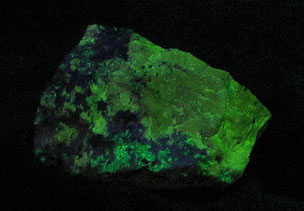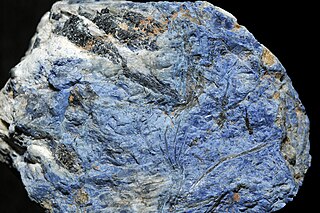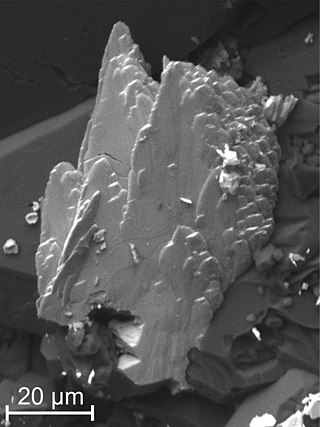
Titanite, or sphene (from Ancient Greek σφηνώ (sphēnṓ) 'wedge'), is a calcium titanium nesosilicate mineral, CaTiSiO5. Trace impurities of iron and aluminium are typically present. Also commonly present are rare earth metals including cerium and yttrium; calcium may be partly replaced by thorium.

Cotunnite is the natural mineral form of lead(II) chloride (PbCl2). Unlike the pure compound, which is white, cotunnite can be white, yellow, or green. The density of mineral samples spans range 5.3–5.8 g/cm3. The hardness on the Mohs scale is 1.5–2. The crystal structure is orthorhombic dipyramidal and the point group is 2/m 2/m 2/m. Each Pb has a coordination number of 9. Cotunnite occurs near volcanoes: Vesuvius, Italy; Tarapacá, Chile; and Tolbachik, Russia.

Bismuthinite is a mineral consisting of bismuth sulfide (Bi2S3). It is an important ore for bismuth. The crystals are steel-grey to off-white with a metallic luster. It is soft enough to be scratched with a fingernail and rather dense.

Esperite is a rare complex calcium lead zinc silicate (PbCa3Zn4(SiO4)4) related to beryllonite and trimerite that used to be called calcium larsenite. It was named in honor of Esper F. Larsen Jr. (1879–1961), petrologist of Harvard University.

Dumortierite is a fibrous variably colored aluminium boro-silicate mineral, Al7BO3(SiO4)3O3. Dumortierite crystallizes in the orthorhombic system typically forming fibrous aggregates of slender prismatic crystals. The crystals are vitreous and vary in color from brown, blue, and green to more rare violet and pink. Substitution of iron and other tri-valent elements for aluminium result in the color variations. It has a Mohs hardness of 7 and a specific gravity of 3.3 to 3.4. Crystals show pleochroism from red to blue to violet. Dumortierite quartz is blue colored quartz containing abundant dumortierite inclusions.

Hutchinsonite is a sulfosalt mineral of thallium, arsenic and lead with formula (Tl,Pb)2As5S9. Hutchinsonite is a rare hydrothermal mineral.

Clausthalite is a lead selenide mineral, PbSe. It forms a solid solution series with galena PbS.

Nagyágite is a rare sulfide mineral with known occurrence associated with gold ores. Nagyágite crystals are opaque, monoclinic and dark grey to black coloured.

Ekanite is an uncommon silicate mineral with chemical formula Ca
2ThSi
8O
20 or (Ca,Fe,Pb)
2(Th,U)Si
8O
20. It is a member of the steacyite group. It is among the few gemstones that are naturally radioactive. Most ekanite is mined in Sri Lanka, although deposits also occur in Russia and North America. Clear and well-colored stones are rare as the radioactivity tends to degrade the crystal matrix over time in a process known as metamictization.

Masuyite is a uranium/lead oxide mineral with formula Pb[(UO2)3O3(OH)2]·3H2O.

Duftite is a relatively common arsenate mineral with the formula CuPb(AsO4)(OH), related to conichalcite. It is green and often forms botryoidal aggregates. It is a member of the adelite-descloizite Group, Conichalcite-Duftite Series. Duftite and conichalcite specimens from Tsumeb are commonly zoned in color and composition. Microprobe analyses and X-ray powder-diffraction studies indicate extensive substitution of Zn for Cu, and Ca for Pb in the duftite structure. This indicates a solid solution among conichalcite, CaCu(AsO4 )(OH), austinite, CaZn(AsO4)(OH) and duftite PbCu(AsO4)(OH), all of them belonging to the adelite group of arsenates. It was named after Mining Councilor G Duft, Director of the Otavi Mine and Railroad Company, Tsumeb, Namibia. The type locality is the Tsumeb Mine, Tsumeb, Otjikoto Region, Namibia.

Aktashite is a rare arsenic sulfosalt mineral with formula Cu6Hg3As4S12. It is a copper mercury-bearing sulfosalt and is the only sulfosalt mineral with essential Cu and Hg yet known. It is of hydrothermal origin. It was published without approval of the IMA-CNMNC, but recognized as valid species by the IMA-CNMNC Sulfosalts Subcommittee (2008).
Scrutinyite is a rare oxide mineral and is the alpha crystalline form of lead dioxide (α-PbO2), plattnerite being the other, beta form. The mineral was first reported in 1988 and its name reflects the scrutiny and efforts required to identify it from a very limited amount of available sample material.

Raspite is a mineral, a lead tungstate; with the formula PbWO4. It forms yellow to yellowish brown monoclinic crystals. It is the low temperature monoclinic dimorph of the tetragonal stolzite.

Matlockite is a rare lead halide mineral, named after the town of Matlock in Derbyshire, England, where it was first discovered in a nearby mine. Matlockite gives its name to the matlockite group which consists of rare minerals of a similar structure.
Dessauite-(Y) is a mineral member of the crichtonite group with the formula (Sr,Pb)(Y,U)(Ti,Fe3+
)
20O
38. It is associated with derbylite, hematite, rutile, karelianite, siderite, and calcite. Founded in the Buca della Vena Mine, Tuscany, Italy, the mineral was called dessauite in honor of professor Gabor Dessau (1907–1983).

Tlapallite is a rare and complex tellurate mineral with the chemical formula (Ca,Pb)3CaCu6[Te4+3Te6+O12]2(Te4+O3)2(SO4)2·3H2O. It has a Moh's hardness of 3 and it is green in colour. It was named after the Nahua word "Tlalpalli", which translates to paint, referring to the paint-like habit of the mineral. Its formula and crystal structure were redefined in 2019, showing it contained a mixed-valence phyllotellurate layer [Te4+3Te6+O12]12−.

Andychristyite (IMA symbol: Acs) is a lead copper tellurate mineral with the chemical formula PbCu2+Te6+O5H2O. Its type locality is the Soda Mountains in California. It was named after Welsh–Australian mineralogist Andrew G. Christy.

Minrecordite, CaZn(CO3)2, is a very rare mineral belonging to the dolomite group, the member with Ca and Zn. It was discovered, associated with dioptase, in a specimen from the Tsumeb mine (Namibia), which is consequently its type locality. Its name is a tribute to The Mineralogical Record magazine, representing the collaboration between professional and amateur mineralogists. In this locality it is associated primarily with dioptase, and less frequently with duftite, calcite and malachite. It is a rare mineral, which has been found only in a few deposits in the world. In addition to the type locality, it appears in the Preguiça mine, in Moura, district of Beja (Portugal).

















